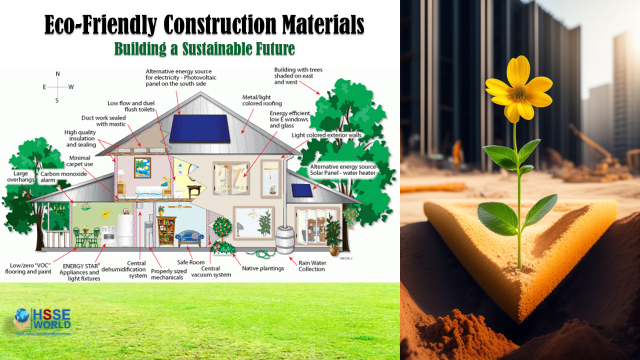
Constructing Tomorrow: The Impact of Sustainable Building Materials
Sustainable building materials are revolutionizing the construction industry, offering environmentally conscious alternatives that prioritize longevity, energy efficiency, and reduced environmental impact. In this article, we’ll delve into the transformative impact of sustainable building materials, exploring their benefits, innovations, and the positive contribution they make to the future of construction.
Environmental Impact: Reducing the Carbon Footprint
One of the primary advantages of sustainable building materials is their reduced environmental impact. Traditional construction often relies on resource-intensive materials with high carbon footprints. In contrast, sustainable materials prioritize eco-friendly sourcing, minimizing extraction and processing while incorporating recycled content. This shift towards greener alternatives helps mitigate environmental degradation and combat climate change.
Energy Efficiency: Enhancing Building Performance
Sustainable building materials contribute to energy-efficient structures. Innovations such as insulated concrete forms, reflective roofing materials, and energy-efficient windows improve a building’s thermal performance. These features reduce the need for excessive heating or cooling, resulting in lower energy consumption and operational costs. The emphasis on energy efficiency aligns with global efforts to create more sustainable and resilient built environments.
Renewable Resources: Embracing Nature’s Bounty
Choosing sustainable building materials often involves prioritizing renewable resources. Bamboo, cork, and reclaimed wood are excellent examples of renewable materials that can replace traditional, less sustainable options. Harvested responsibly, these materials promote biodiversity, support local economies, and contribute to a circular economy where resources are used efficiently and responsibly.
Recyclability and Reusability: Closing the Loop
A hallmark of sustainable building materials is their recyclability and reusability. Many sustainable materials can be recycled at the end of their lifecycle or repurposed in other construction projects. This “cradle-to-cradle” approach minimizes waste, reduces the burden on landfills, and supports the circular economy model, where materials are continuously reused and recycled, closing the resource loop.
Durability and Longevity: Building for Generations
Sustainable building materials often boast superior durability and longevity compared to their traditional counterparts. High-quality materials like recycled steel, reclaimed bricks, and engineered wood products can withstand the test of time. Constructing buildings with a focus on longevity not only reduces the frequency of replacements but also minimizes the environmental impact associated with constant renovations and demolitions.
Indoor Air Quality: Creating Healthy Living Spaces
The impact of sustainable building materials extends beyond the exterior envelope of a structure. Many of these materials contribute to improved indoor air quality. Low-VOC paints, natural insulation materials, and non-toxic finishes reduce harmful emissions and create healthier living and working environments. Prioritizing indoor air quality is integral to ensuring the well-being and comfort of occupants.
Innovations in Sustainable Concrete: Paving the Way Forward
Concrete is a fundamental construction material, and innovations in sustainable concrete are paving the way for greener building practices. The use of supplementary cementitious materials, such as fly ash or slag, reduces the reliance on traditional cement production, which is a significant source of carbon emissions. Additionally, advancements in self-healing concrete and 3D printing technology are reshaping the possibilities for sustainable construction.
Green Roofs and Living Walls: Natural Integration
Sustainable building materials extend to the exterior of structures with the incorporation of green roofs and living walls. These features not only enhance the aesthetic appeal of buildings but also provide insulation, reduce urban heat island effects, and support biodiversity. Green roofs and living walls exemplify the harmonious integration of the built environment with nature.
Cost-Effective Solutions: Long-Term Savings
While the initial costs of some sustainable building materials may be higher, the long-term savings they offer make them cost-effective choices. Energy-efficient materials contribute to lower operational costs over the life of the building. Additionally, durable and low-maintenance materials reduce the need for frequent repairs or replacements, providing economic benefits in the long run.
Industry Collaboration and Education: Shaping the Future
The widespread adoption of sustainable building materials requires collaboration within the construction industry and a commitment to education. Architects, builders, and policymakers play pivotal roles in advocating for and implementing sustainable practices. Industry collaboration fosters innovation and ensures that sustainable building materials become the standard rather than the exception.
A Sustainable Future: Choosing Wisely Today
In conclusion, the impact of sustainable building materials goes beyond the structures they create; it influences the well-being of the planet and its inhabitants. By prioritizing environmental considerations, embracing renewable resources, and investing in innovative technologies, the construction industry is shaping a more sustainable future. Choosing sustainable building materials today is an investment in a resilient, eco-friendly, and harmonious built environment.
For more information on Sustainable Building Materials, visit Joscorena.my.id.
